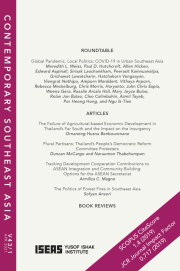Juhn Chris Espia , Weena Gera , Rosalie Arcala Hall

The Philippine national government’s largely ineffective response to the COVID-19 pandemic sets the context for a diversity of policy adaptations at the local level. This article focuses on the two largest metropolitan areas in the Visayan Islands, Cebu City and Iloilo City. The Cebu City government, with strong personal ties to [End Page 53] President Rodrigo Duterte, acquiesced to the national government’s takeover with uniformed personnel deployed for enforcement. The Iloilo City government, lacking such ties, pushed back and pursued innovative strategies including frequent use of appeals against national government quarantine classifications. The cases depict constricted decision-making space for local governments to balance public health safety and economic reopening. This is especially problematic given the deficiencies in the central government’s pandemic response.
The Philippine government was expected to play a major role in coordinating an appropriate delivery of public health services amid limited capacity for tertiary care and testing outside Manila. Its response to the pandemic, however, has revealed the inadequacies in the country’s public health infrastructure and underlying tensions between the president together with executive agencies and local governments. The national Inter-Agency Task Force for the Management of Emerging Infectious Diseases (IATF), activated under the March 2020 Bayanihan to Heal as One Act, was the coordinating mechanism within the framework of “a national-government-enabled, Local Government Unit (LGU)-led, and people-centered response”.1 Its effectiveness in reducing the rate of infections, however, was undercut by the evident lack of capacity across many national government agencies, leading eventually to IATF ceding much of its decision-making powers to local governments. Vested with emergency powers, President Duterte compelled local governments to obey IATF directives, deployed the military to implement lockdown measures, and released US$5.7 million in emergency funding to tackle the coronavirus. These emergency powers amplified the importance of President Duterte, and local responses were thus heavily influenced by ties (or lack thereof) between the supremo in Manila and local leaders.2
There are five areas in which LGU implementation of measures proved contentious: first, testing and contact tracing protocols; second, community quarantine classification with the corresponding restrictions; third, repatriation of returning overseas Filipinos and locally stranded individuals; fourth, opening of business establishments and return to work; and fifth, coordination between the Department of Health (DOH) offices and the local emergency operations centres for data collection and reliability. National health officials did not allow local governments to conduct rapid testing and insisted instead on correct science-backed protocols. When the national government pushed its Balik-Probinsya (Return to the Province) plan, large numbers of people had to be transported [End Page 54] to their hometowns alongside thousands of retrenched overseas Filipino workers (OFWs). Receiving and sending local governments had to tag, report and manage these returnees, and shoulder the costs of transporting them to their homes and quarantine facilities. Meanwhile, LGUs worked within the guidelines issued by the IATF on suspension of non-essential work, closure of business establishments and restrictions on public transport services and public gatherings. The strong leadership role asserted by the national government is evident in the language of IATF resolutions “enjoining” and “directing” LGUs to enact ordinances strictly in line with its guidelines, and to refrain from imposing additional requirements. LGU compliance with IATF directives and reporting of data were checked by the national agencies. President Duterte also threatened to prosecute local government officials who were not abiding by national government directives.3 The Department of the Interior and Local Government (DILG) issued several “show-cause” orders to various local government officials, demanding explanations from those who had been deemed non-compliant with quarantine policies or who were thought to have committed violations in the disbursement of emergency assistance.
Iloilo and Cebu, the two most populous cities in the Visayan Islands, illustrate contrasting cases of local government responses to the pandemic.4 Both experienced dramatic surges in community transmissions, but while the national government deployed the military and took over the lockdown implementation in Cebu, it…
Link to the Article